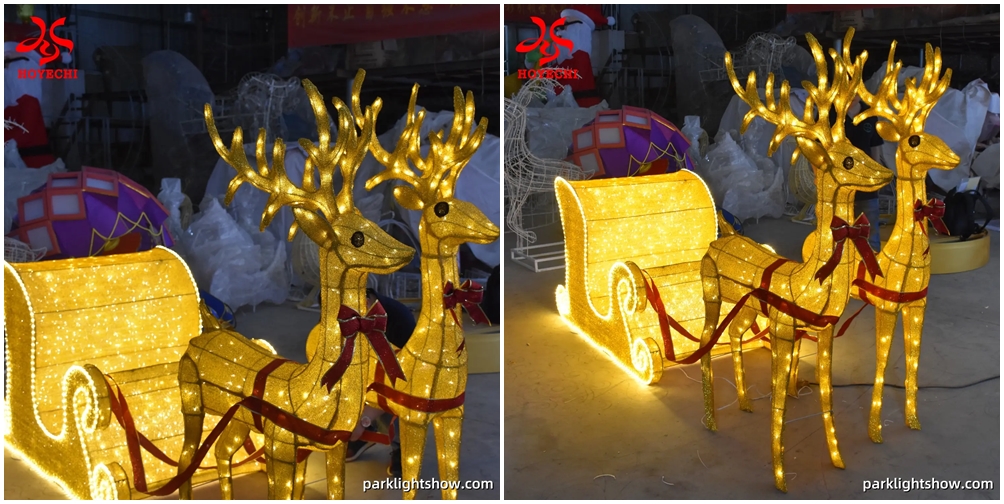How to Do a Light Show for Christmas: A Complete Guide to Planning a Large-Scale Display
During the holiday season, light shows have evolved from simple decorative displays into immersive, large-scale experiences that attract families, tourists, and local residents alike. With growing public interest in visual storytelling and interactive environments, a successful light show for Christmas today must be more than just dazzling lights—it must deliver emotion, atmosphere, and value. This guide will walk you through the essential steps for planning, designing, and operating a professional holiday light show project.
1. Define the Objective: Audience and Venue Analysis
Start by identifying your target audience and understanding the venue’s specific conditions. Tailoring your show to the preferences and behavior of your visitors is key to success:
- Families with children: Best suited for interactive games, cartoon-themed lanterns, or candyland-style scenes.
- Young couples: Romantic installations such as light tunnels and photo zones under giant Christmas trees work well.
- Tourists and local residents: Prioritize accessibility, transportation, and surrounding amenities.
Additionally, factors like venue size, terrain, infrastructure (power, drainage, emergency access), and urban regulations will impact your display strategy. A park, shopping mall plaza, or resort will each demand a different approach.
2. Create a Thematic Narrative: Let the Lights Tell a Story
A great light show for Christmas needs a clear narrative. Rather than simply showcasing lights, think in terms of chapters and emotional beats. Recommended theme ideas include:
- Classic Christmas tales such as “Santa’s World Tour” or “The North Pole Adventure”
- Winter fantasy settings like “Frozen Forest” or “The Ice Kingdom”
- City culture fusion: integrating local landmarks with holiday themes
- Cross-genre creativity: Christmas + animal kingdom, planets, or fairy tales
Through synchronized lighting, music, and staged installations, you create an immersive journey that enhances visitor engagement and social sharing potential.
3. Build the Visual Core: Giant Lanterns and Dynamic Installations
Your visual identity will be driven by key centerpiece elements. For large-scale Christmas light shows, we suggest including the following components:
- Giant Christmas Tree Installation: Often the central piece, programmable with gradient or sparkling light effects.
- Santa-Themed Lantern Displays: Sleighs, reindeer, and gift boxes work well as interactive photo areas.
- LED Light Tunnels: Dreamlike walk-through tunnels that pulse with sound-activated rhythms.
- Interactive Projection Zones: Ground or wall projections that respond to motion or touch.
- Timed Light Theatre Shows: Scheduled storytelling performances using light choreography and sound.
4. Project Timeline and Budget Planning
Proper scheduling and budgeting ensure smooth execution. Here’s a sample timeline for a Christmas light show:
| Project Phase | Suggested Timeframe | Description |
|---|---|---|
| Concept Development | 5–6 months prior | Theme design, site analysis, initial budget planning |
| Design Finalization | 4 months prior | Technical drawings, 3D renders, bill of materials |
| Manufacturing | 3 months prior | Production of lanterns, steel structures, and lighting systems |
| Installation | 1 month prior | On-site assembly, power setup, testing |
| Testing & Opening | 1 week prior | System check, safety inspection, final adjustments |
Budget considerations should include design costs, production, logistics, labor, lighting equipment, and maintenance. For custom-made or oversized installations, freight and structural reinforcement are also critical factors.
5. Ensure Safety and User Experience
Operational safety and audience flow must be integrated into every design and execution step:
- Electrical safety and waterproofing: Use outdoor-grade cables, junction boxes, and lighting rated for all-weather conditions.
- Pedestrian traffic planning: Design clear pathways, adequate signage, and emergency exits.
- Guidance and interactivity: Consider QR code maps, live guides, scheduled broadcasts, or interactive exhibits.
- Cleanliness and sanitation: Schedule frequent cleaning during peak hours and provide waste bins throughout the venue.
- On-site amenities: Rest areas, snack stalls, or seasonal markets enhance dwell time and comfort.
6. Maximize Value Through Diverse Monetization Strategies
Beyond the light show itself, multiple avenues exist to generate revenue and long-term impact:
- Brand sponsorships and naming rights: Offer visibility opportunities to local businesses or corporate partners.
- Ticketed entry and timed access: Optimize flow and monetize through advance booking systems.
- Social media campaigns: Encourage UGC (user-generated content) and viral sharing through hashtags, challenges, or influencer collaborations.
- Merchandising: Sell themed souvenirs, light-up toys, holiday décor, or DIY kits as event memorabilia.
With the right planning, your light show for Christmas can become not just a seasonal event, but a cultural highlight and commercial success story.
Post time: Jul-15-2025





